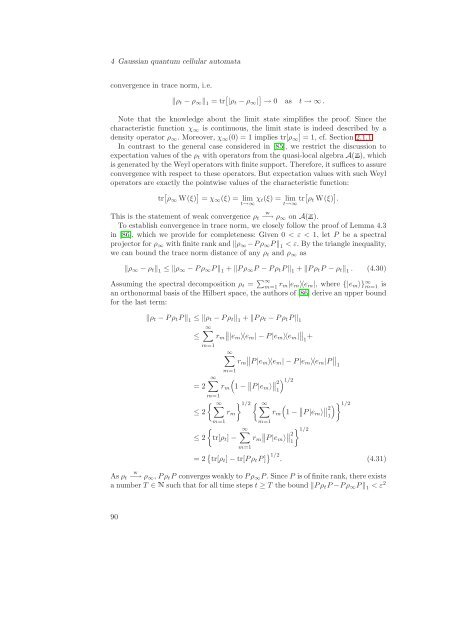Quantum Information Theory with Gaussian Systems
Quantum Information Theory with Gaussian Systems
Quantum Information Theory with Gaussian Systems
You also want an ePaper? Increase the reach of your titles
YUMPU automatically turns print PDFs into web optimized ePapers that Google loves.
4 <strong>Gaussian</strong> quantum cellular automata<br />
convergence in trace norm, i.e.<br />
ρt − ρ∞ 1 = tr |ρt − ρ∞| → 0 as t → ∞ .<br />
Note that the knowledge about the limit state simplifies the proof. Since the<br />
characteristic function χ∞ is continuous, the limit state is indeed described by a<br />
density operator ρ∞. Moreover, χ∞(0) = 1 implies tr[ρ∞] = 1, cf. Section 2.1.1.<br />
In contrast to the general case considered in [85], we restrict the discussion to<br />
expectation values of the ρt <strong>with</strong> operators from the quasi-local algebra A(), which<br />
is generated by the Weyl operators <strong>with</strong> finite support. Therefore, it suffices to assure<br />
convergence <strong>with</strong> respect to these operators. But expectation values <strong>with</strong> such Weyl<br />
operators are exactly the pointwise values of the characteristic function:<br />
tr ρ∞ W(ξ) = χ∞(ξ) = lim<br />
t→∞ χt(ξ) = lim<br />
t→∞ tr ρt W(ξ) .<br />
This is the statement of weak convergence ρt<br />
w<br />
−→ ρ∞ on A().<br />
To establish convergence in trace norm, we closely follow the proof of Lemma 4.3<br />
in [86], which we provide for completeness: Given 0 < ε < 1, let P be a spectral<br />
projector for ρ∞ <strong>with</strong> finite rank and ρ∞ −Pρ∞P 1 < ε. By the triangle inequality,<br />
we can bound the trace norm distance of any ρt and ρ∞ as<br />
ρ∞ − ρt 1 ≤ ρ∞ − Pρ∞P 1 + Pρ∞P − PρtP 1 + PρtP − ρt 1 . (4.30)<br />
Assuming the spectral decomposition ρt = ∞<br />
m=1 rm|em〉〈em|, where {|em〉} ∞ m=1 is<br />
an orthonormal basis of the Hilbert space, the authors of [86] derive an upper bound<br />
for the last term:<br />
As ρt<br />
ρt − PρtP 1 ≤ ρt − Pρt 1 + Pρt − PρtP 1<br />
≤<br />
= 2<br />
∞<br />
m=1<br />
∞<br />
m=1<br />
<br />
rm<br />
|em〉〈em| − P |em〉〈em| + 1<br />
∞<br />
m=1<br />
rm<br />
<br />
∞<br />
≤ 2<br />
≤ 2<br />
m=1<br />
<br />
rmP<br />
|em〉〈em| − P |em〉〈em|P <br />
1<br />
<br />
1 − P |em〉 2 1<br />
rm<br />
<br />
tr[ρt] −<br />
1/2 ∞ <br />
∞<br />
m=1<br />
m=1<br />
<br />
rm<br />
rm<br />
1/2<br />
P |em〉 2<br />
<br />
1 − P |em〉 2 <br />
1<br />
1/2 1<br />
1/2<br />
= 2 tr[ρt] − tr[PρtP] 1/2 . (4.31)<br />
w<br />
−→ ρ∞, PρtP converges weakly to Pρ∞P. Since P is of finite rank, there exists<br />
a number T ∈Æsuch that for all time steps t ≥ T the bound PρtP −Pρ∞P 1 < ε 2<br />
90
















